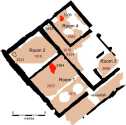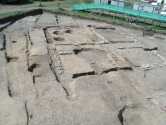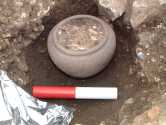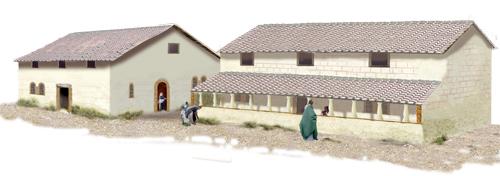


Showing (from left to right): Early Roman Masonry Building 2, view from the north-east, view from the south-west.
Object 50019 | Matrix 296 (SVG)



Showing (from left to right): Early Roman Masonry Building 2, view from the north-east, view from the south-west.
Some 4.0m to the south-west of the surviving end-wall of ERMB1, perhaps 2.0m if the corridor continued on this side, a second house, Early Roman Masonry Building 2 (ERMB2), square in plan and of four rooms, was constructed on the same north-east/south-west orientation. The outer walls entirely contained the extent of the underlying, Period 1, circular structure. Like ERMB1, its foundations, which had been robbed to a considerable extent, were of coursed and knapped flint, measuring 0.6m in width and 0.35m in depth. The foundations of the south-west wall were deeper, perhaps to compensate for visible subsidence into an underlying pit or well.
The building was bisected by a corridor, just over 1.0m wide, on the north-west/south-east orientation. On its south-western side were two reception rooms, the larger (Room 1) measuring 6.0 by 7.0m, the smaller (Room 2), 6.0 by 5.0m.An almost complete (but fragmented) Silchester Ware jar SF2039 from cut 3321 was buried in the north-west corner of Room 2, while a complete Alice Holt bead-rim jar SF2549 from cut 3933 was buried at the northern end of the corridor. The Silchester Ware jar would certainly have been residual by the early–mid 2nd century, while the Alice Holt jar was close to the end of its production life. These dates raise the possibility that the pots relate to the previous ERTB3, as has been discussed in that context.





Showing (from left to right): complete Alice Holt jar SF02549 and Silchester Ware jar SF02039
To its north-east were two smaller rooms, one in the south-east corner (Room 3) measuring 3.0 by 3.5m, the other in the north-west corner (Room 4), measuring 5.0 by 4.0m. Between these two rooms was an open area continuous with the corridor. While this may have served as an entrance lobby with the main door looking across to Early Roman Masonry Building 1, it is also likely that the corridor had doors opening out at each end.
No traces of original flooring survived, the exposed make-ups consisting of yellow clay 1818 (Room 2), 2023/3375 (Room 1), 3680 (Room 3), 3382 (Room 4) and clay and gravel 4354 and 3678 in the bisecting corridor. In two rooms, close to their north-west walls, were patches of burnt clay suggestive of hearths; 3384 in Room 1 and 3309 in Room 4.
The stratigraphy associated with the exterior of the building outside the south-east-facing wall suggests the existence of a verandah, which closely follows the position of the post pads which we associate with ERTB3.



Early Roman Masonry Buildings 1 and 2 (reconstruction by Margaret Matthews) and aerial views from the south west.
There is no surviving evidence to suggest room function, but it is suggested that Rooms 1 and 2 probably served as reception rooms. Room 4 may have been a bedroom, while the smallest, and possibly the most isolated, room (3) beside the entrance lobby might have provided accommodation for household slave(s). As with ERMB1 there is no evidence for a kitchen, and that function may have continued to have been served by ERTB4. Nevertheless the building seems to have been intended for residential occupation. While the foundations are more modest than those of ERMB1, they were still capable of supporting an upper storey.
The recovery of two complete sets of toilet instruments, which are rare as site finds, has suggested to Nina Crummy that their incorporation in the make-ups of the building was deliberate and possibly votive. With the pottery and the glass it is difficult to isolate finds which might be contemporary with the construction and use of the building, but the two complete pottery vessels buried as foundation deposits are notable exceptions. While the Silchester Ware jar belongs to a ware which ceased production by the early Flavian period, the Alice Holt jar is of a type which began production in the Neronian-early Flavian period. Among the animal bone assemblage, Ingrem notes the relatively high proportion of cattle bone from this building.
The latest samian is Hadrianic/early Antonine, giving a terminus post quem of c. 125/50, but there is little 2nd-century coarse ware.
© Internet Archaeology
URL: http://intarch.ac.uk/journal/issue21/4/p3_ermb2.htm
Last updated: Wed Sept 12 2007